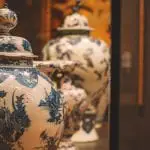One of the primary colors, blue, has a place of significance in the world today. In particular, the color blue plays a huge role in the way the human mind functions, making it a very powerful tool that can be harnessed in various ways.
In this research paper, we’ll explore the various ways in which the color blue has an impact on the human mind.
The impact of the color blue on human evolution
Blue has played an important role in the way the human brain and visual sense have evolved.
Around 90 million years ago, our ancestors had evolved only red-sensitive and UV-sensitive color genes to help them hunt at night. But around 30 million years ago, we evolved to hunt at all times of the day and night. So, early primates needed to be able to see the color blue and differentiate it from other colors to keep themselves safe. In this way, the color blue (as with other colors) helped us develop special opsin genes that allowed us to see the full spectrum of light.
As early humans became more conscious of their surroundings, they noticed the myriad colors of nature. This included how the sky appeared to the naked eye or how water from a stream looked on a clear and sunny day. Our ancestors learned to recognize the color blue without calling it “blue.” The color’s presence in the limitless sky and in nurturing water made it very special to them.

(Block of Lapis Lazuli – Source: Wikimedia Commons)
Another factor that added to the allure of blue was its rarity. Compared to other colors such as black, white, red, green, and yellow, blue isn’t very easily available in nature. Naturally blue flowers like Delphiniums & Himalayan blue poppies and birds like blue jays are located in specific regions of the world. Blue colored minerals like lapis lazuli, turquoise, azurite, and sapphire were also hard to mine and endemic to certain regions of the globe.
These circumstances made early humans think of blue as a rare and precious color. When and if they could find it, early humans used blue in cave paintings to depict important aspects of their life. Studies of ancient African cave art show that the blue they used is highly-unusual and not found in any other cave paintings around the world.
In fact, it was this search for different hues of colors (such as shades of blue) for their art that scientists believe allowed early humans to improve their visual perception.
Impact of blue on human curiosity
As civilizations grew and progressed, demand for natural blue increased. But being a rare color, blue wasn’t easily available to everyone. This was the impetus that made people curious to find materials that could help them develop synthetic blue pigments.
The first synthetic blue pigments were made around 2575-2467 BCE in Egypt by mixing alkali, silica, copper, and lime. This “Egyptian Blue” was exported to other parts of the world so that it could be used for textiles and art.
In medieval Europe, the blue textile dye was made using pigments from a Mediterranean flowering plant called “Woad.” But because it was very difficult to obtain this plant and to make the dye, blue color was affordable only by royalty. This is why you’ll find so many artworks of ancient kings and queens clad in blue.
Impact of blue on mood, behavior & thoughts
Colors evoke specific moods and emotional responses in us because of three reasons:
- Biological/evolutionary conditioning
- Cultural/religious imprinting
- Personal psychological identification
We have already explored the role of biological/evolutionary conditioning on the preference for the color blue in the previous sections.
Now we come to the role of cultural/religious imprinting of colors and their impact on mood. In early Christian iconography, The Virgin Mary was depicted draped in robes of dark blue, and soon, the color became synonymous with peace, motherly love, trustworthiness, and innocence.

(“Virgin and Child with Female Saints” by Gérard David, 1500. (Source: Wikimedia Commons))
In Hinduism, many gods and goddesses are depicted having blue skin because their blue aura represents their “all-pervasive and all-inclusive” nature. In oriental countries, blue is considered good fortune. Blue paint is used outside homes and office spaces to invite good spirits inside. In Egypt, blue symbolizes life, while in China, it represents immortality.
In many Islamic countries, blue is thought to represent cleanliness, faith, and spirituality, while in many African nations, blue is thought to represent togetherness and love.
Looking at blue makes people feel happy, included, and at-peace. This is one reason why many places of worship are constructed using blue tiles, mosaics, and stained glass.
In fact, you can see this cultural imprinting play out in today’s organizations – specifically banks, stock companies, technology providers, and healthcare providers. These institutions use blue color on their logos and branding to evoke a sense of trust.
Apart from these beliefs, blue also symbolizes power. Many countries use the color blue in their flags to showcase their courage, alertness, sense of justice, and good fortune. This is also why you’ll see many presidents and CEOs having blue-based wardrobes.
Finally, we come to the impact of personal identification on the preference for blue. Take Pablo Picasso, for example. To him, blue signified sadness, melancholy, and despair. His Blue Period (1900-1904) saw him using the color blue extensively to showcase his despair at the death of his friend Carlos Casagemas.
To other artists like Renoir, Vermeer, Parrish, and Frankenthaler, blue represented calmness, healing, and nature. This is why you’ll see their works using shades of light blue or cerulean extensively.
For others, such as artist Yves Klein, blue represents their own personal life philosophy. So enamored was Klein by blue that he had his own patented blue paint created, which he used in all his artworks.
Impact of blue on gender perception
When we’re talking about the effect of blue on the human mind, we can’t ignore the pervasive impact it has on our perception of gender. For decades, blue has been a boy color, while pink has been a girl color.

(Baby booties – Source: Pixabay)
Studies show that segregating and allocating colors to specific genders (such as pink for girls and blue for boys) increases the tendency to self-stereotype and causes limiting behaviors to manifest. The inability or unwillingness to comply with these gendered color connotations can make people feel inadequate. This can be particularly damaging for children.
This type of gender stereotyping is least visible in children under the age of two. But by the time they were two and over, children start to choose the gendered colors that have been exclusively allocated to their sex. But the fact, is many alternate studies have shown that in the absence of such stereotyping, both girls/women and boys/men prefer blue equally.
Impact of blue on cognition, learning & memory
Did you know that blue enhances creative cognition? In comparison, the color red improves our attention to detail. These studies prove that in cognitive tasks that require participants to use their imagination, those who had blue-colored visual cues performed 2X better than those who had a different colored visual cue. Additionally, another study shows that exposure to blue-enriched lighting in the morning boosts wakefulness and improves reaction time on activities/tests.
The effect of blue on cognition doesn’t end with creativity. It’s been found that blue has a deep impact on learning and memory as well. This is one of the reasons why blue paint is recommended for pre-school walls. Blue is soothing, and when used in nap rooms, facilitates sleep. Napping after a class of learning allows young children’s minds to collate and process the new information, helping them perform better cognitively.
Blue has also been found to help autistic children differentiate between facial features and expressions. One theory explaining this is that primary colors like blue allow autistic children to see the nuanced differences between each facial expression, which might not be so easily visible in secondary/tertiary colors.
Older adults, especially people with dementia, have also been found to cognitively benefit from the color blue. Studies show that using blue in the residential care facilities lowers blood pressure and keeps dementia patients mentally calm. This helps them cope with their degenerative symptoms better. Additionally, it’s been found that providing blue-colored crockery and cutlery to dementia patients helps them see their food better and use their utensils easily.

(Blue Colored Brand Logos – Source: Logomaker.com)
Impact of blue on marketing success (or failure)
Did you know that more than 85% of customers cite color as the main reason for purchasing a particular brand/product?
When it comes to blue, people prefer blue packages because the color blue evokes a sense of dependability, elegance, and expertise. We know this is why so many companies use blue in their marketing.
Recent research shows that blue also functions as a neural relaxant. Compared to colors like red, orange, and yellow (which increase muscle activity and heart rate), the color blue calms our nervous and muscular systems, putting us at ease. Seeing products clad in blue packaging can make you feel happier and more satisfied. Additionally, it’s also been found that using blue-packaged products makes time fly by because you are so relaxed.
When it comes to using blue online, it’s been found that darker blue backgrounds lend an air of authority to the company website. But light or bright/neon blue shades are great for drawing eyeballs to the company deals and contact details. Similarly, light shades of blue (such as sky blue) have been found to have a positive sales effect on shoppers who have traditional tastes.
Blue – an abstraction or a real color?
Consider this. Millennia-old mythological epics like the Mahabharata or the Odyssey mention colors like “red,” “wine,” and “blood.” There are also references to “sun-like” colors (presumably yellow or white). Even ancient Egyptian scrolls and other early codified messages mention many colors including blacks, browns, violets, and so on. But not one of them mentions the color “blue.”
This brings us to a very interesting question – is blue a real color or a linguistic concept?
You see, the language we speak and the colors we see are intrinsically connected to each other. In a groundbreaking study done by Paul Kay and Brent Berlin, it was found that in the absence of language, we cannot perceive the full spectrum of colors. According to the results of the study, we can only see colors that we have names for.
In the study, groups of British participants, who knew the English names for different kinds of blue, were able to recognize those blues. But the Himba tribe from Namibia, which had no words for blue, were unable to recognize blues at all. In fact, according to the Himba, blue was a variant of green.
Another similar study done in Australia proved that color linguistics evolves the more we interact with people speaking other languages. This allows us to perceive newer shades of blue each time.
A recent MIT study may have a clue to this strange occurrence. According to the study, the human mind has an easier time categorizing and labeling warmer colors like red, orange, yellow, and brown than cooler colors like blue and green. Therefore, we tend to divide warmer colors into sub-colors more often while leaving cooler colors as a single unit. The resultant linguistic barrier affects our ability to perceive cooler colors like blue.
These studies prove that the color blue has a very dynamic effect on the human mind even today. This color continues to challenge us and inspire us. Blue is one of science’s biggest mysteries and one of the greatest tools that allow us to expand our cognitive abilities, creativity, and language.


